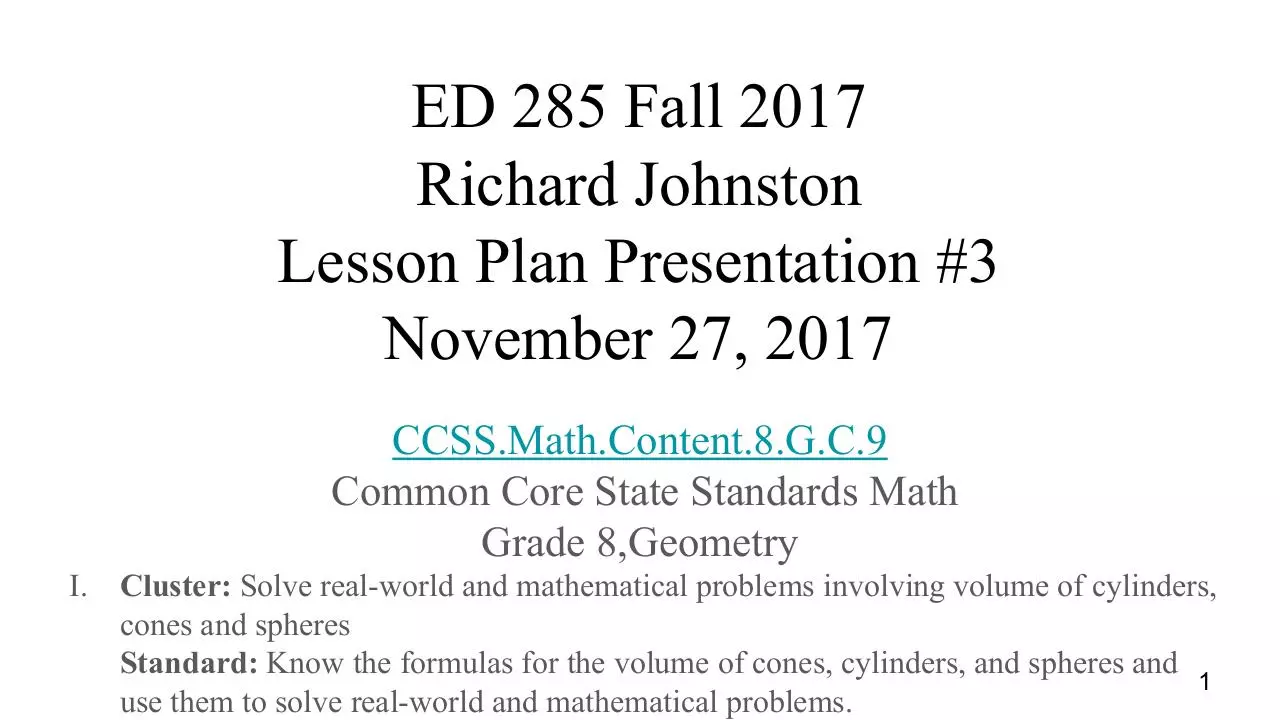Lesson Plan Presentation Richard Johnston (PDF)
File information
This PDF 1.4 document has been generated by Google / , and has been sent on pdf-archive.com on 29/11/2017 at 08:50, from IP address 75.85.x.x.
The current document download page has been viewed 324 times.
File size: 448.62 KB (16 pages).
Privacy: public file





File preview
ED 285 Fall 2017
Richard Johnston
Lesson Plan Presentation #3
November 27, 2017
CCSS.Math.Content.8.G.C.9
Common Core State Standards Math
Grade 8,Geometry
I.
Cluster: Solve real-world and mathematical problems involving volume of cylinders,
cones and spheres
Standard: Know the formulas for the volume of cones, cylinders, and spheres and
1
use them to solve real-world and mathematical problems.
Shapes Lesson Plan
II. Framework:
The ability to describe items is crucial and this lesson will explore some basic shapes that you will encounter on a
daily basis. This lesson is targeted for eighth grade students to help them visualize and identify the use of shapes in
everyday life.This can be an exploration of an art activity but is essential to math skills and learning geometry.
We will read about shapes and discuss the shapes and how they are essential in building and decorative applications.
The students will complete a practical experiment to calculate volume of water needed in aquaponics container.
This of interest with our own aquaponics garden here at Wahiawa Middle School where we can sample the results.
Sphere
Cube
Cone
Cylinder
2
Shapes Lesson Plan
III. Context and Motivation:
The teacher will bring the class to attention and display flash cards and discuss the various shapes to help the
students to identify the main items of the shape patterns to be explored.
More in depth description and emphasis of the importance of shape recognition in our everyday life.
Explain and describe the shape project and identify importance of understanding shapes.
Identification of spatial skills helps with simple tasks as merging into traffic to complex image analysis of X-rays.
Sphere
Cube
Cone
Cylinder
3
Shapes Lesson Plan
IV. Teacher Modeling:
Visualization; help class to identify circle in sphere, triangle in cone, square in cube
The class including the teacher will explore with a circle, triangle, rectangle and square to use
different shapes to draw our body. We will then color in our\shapes we made to draw a picture of ourselves.
Following teacher and imitation of the procedure by the students offers encouragement and involvement
Sphere
Cube
Cone
Cylinder
4
Shapes Lesson Plan
V. Guided Practice:
The teacher can read a story regarding shapes.
Stories of interest are of nonfiction to pursue teaching concepts.
This will encourage the students to think of the shapes in a different manner and how they can be used
in general discussions to better describe objects.
Sphere
Cube
Cone
Cylinder
5
Shapes Lesson Plan
VI. Independent Practice and Assessment:
The students will be presented with a worksheet that depicts each shape of a circle, rectangle triangle and square to
help them to understand the shapes recently introduced.
Multiple ways of learning to teach subject areas to enhance the learning experience.
Challenges to be encountered is the limitation of some individuals not being able to discern shapes within the
specified drawings and require more teacher intervention in explaining spatial geometric shapes.
Sphere
Cube
Cone
Cylinder
6
Shapes Lesson Plan
Closure:
A worksheet will be given to the students to take home and locate the various shapes they find at home.
They should describe the object and explain the use of the item in the home.
Exploration to find the various shapes at home of common items will strengthen the learning of a new subject.
Follow the link to view this Shapes Lesson Plan on You Tube:
Sphere
Cube
Cone
Cylinder
7
Shapes Lesson Plan
Materials:
Chart paper and plain lined sheets of paper, along with crayons and pencils to make the drawings
of the shapes being explored.
Learning is expanded by reading about the shapes and learning what an object shape picture looks
like but drawing the shapes enhances the learning experience.
Sphere
Cube
Cone
Cylinder
8
Shapes Lesson Plan
Time needed:15 minutes before the lesson, a 90-minute lesson (or split into two shorter lessons), and 15 minutes in a
follow-up lesson review. Timings given are only approximate. Exact timings will depend on the needs of the class.
Similar timing to be used for more in depth examination of volume equations and practice.
Sphere
Cube
Cone
Cylinder
9
Download Lesson Plan Presentation Richard Johnston
Lesson Plan Presentation Richard Johnston.pdf (PDF, 448.62 KB)
Download PDF
Share this file on social networks
Link to this page
Permanent link
Use the permanent link to the download page to share your document on Facebook, Twitter, LinkedIn, or directly with a contact by e-Mail, Messenger, Whatsapp, Line..
Short link
Use the short link to share your document on Twitter or by text message (SMS)
HTML Code
Copy the following HTML code to share your document on a Website or Blog
QR Code to this page

This file has been shared publicly by a user of PDF Archive.
Document ID: 0000702782.